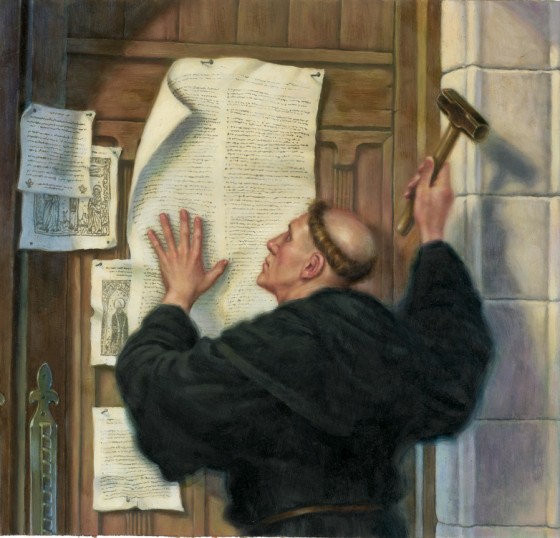
This Monday (October 31) is Reformation Day, commemorating and celebrating the Reformation. It takes place each year on the anniversary of Martin Luther’s nailing of the 95 Theses on the Wittenberg Door on October 31, 1517.
For pastors (and others) who might want some resources in preparation, here are a few recommendations:
1. Last year I interviewed Carl Trueman about the 95 Theses. It’s a nice way to get a brief introduction to what happened.
2. There are a number of accessible introductions to the Reformation, but if you want to focus on Luther’s life and theology, a great choice would be Stephen Nichols’s Martin Luther: A Guided Tour of His Life and Thought. J. I. Packer writes, “For half a century, Bainton’s Here I Stand has been the best introduction to Luther. Stephen Nichols’s engaging volume is in many ways better than Bainton’s for this purpose. It deserves to be widely read.” Nichols also has a good introduction to the 95 Theses.
3. The 2003 movie on Luther starring Joseph Fiennes is surprisingly well-researched and reconstructed. Here is their depiction of the 95 Theses:
4. The Diet of Worms (1521) was where Luther gave his famous “Here I Stand” speech. (Although “Diet of Worms” sounds like an exotic diet, the Imperial Diet was the general assembly of the imperial estates of the Holy Roman Empire, and Worms [pronounced more like verms] was a German town on the western bank of the Rhine River). This is a fascinating and momentous event in history. Here’s a great website for learning more about what happened.
The clip below from the Luther film portrays Luther arriving in Worms after completing his 15-day, 300-mile journey from Wittenberg on April 17, 1521. At 4 PM he was taken to the Bishop’s Court and waited for two hours to see the Emperor. Then at 6 PM he appeared before the Diet, led by Charles V, the 21-year-old Emperor of the Holy Roman Empire, and Johann Eck, his spokesman. Along with them were the Roman advisers and representatives, Spanish troops, and the German political elite.
Luther was asked two questions: Do you acknowledge having written these twenty books lying here? Are you prepared to retract them as a whole or in part?
Luther was taken aback; he was expecting debate, not a yes or no answer. After Luther’s lawyer Hieronymus Schurff objected, “Let the titles of the books be read!” Luther responded in a barely audible voice: “The books are all mine and I have written more.”
As to the second question, Luther responded: “This touches God and his word. This affects the salvation of souls. Of this Christ said, ‘He who denies Me before men, him will I deny before My father.’ To say too little or too much would be dangerous. I beg you, give me time to think it over.”
The assembly reluctantly gave him 24 hours to think it through. He responded the next evening with his famous answer. You can watch the depiction below:
For an audio overview using good historical sources, you can’t beat Max McLean’s Here I Stand album. They have kindly made the whole thing available for free on YouTube:
1. Introduction
2. The Road to Reformation
3. Luther’s Prayer
4. Here I Stand
5. Eck’s Response to Luther
6. Luther’s Final Response
7. Conclusion
8. Sources and Closing Comments
Total Time: 24 minutes
5. I have mentioned in previous posts some good books for children related to Luther. For example, the illustration at the top of this post was painted by Greg Copeland (and used by permission of Concordia Publishing House) and can be found in Paul Maier’s book for older kids, Martin Luther: A Man Who Changed the World. I’ve also posted on the new graphic novel about Luther.
But I would be remiss not to mention a brand-new children’s book published by Crossway, written by R.C. Sproul, and illustrated by T. Lively Fluharty, called The Barber Who Wanted to Pray. It tells the true story of Luther’s writing A Simple Way to Pray in response to his barber’s request for help with his prayer life. Even books like these are designed to be read to children, Dr. Sproul has said, “Ultimately, my target audience in a children’s story is the parents who are reading the stories to their children.” We can all learn a lot from this simple book. You can explore it below:
Luther—like all of us—was a flawed man with feet of clay. He didn’t see or say everything right. But God used him to recover the gospel and to reform the church, and it is fitting to thank God for this remarkable man and God’s grace to him and through him.

















